PART. 2
Europe’s Oldest Engraving
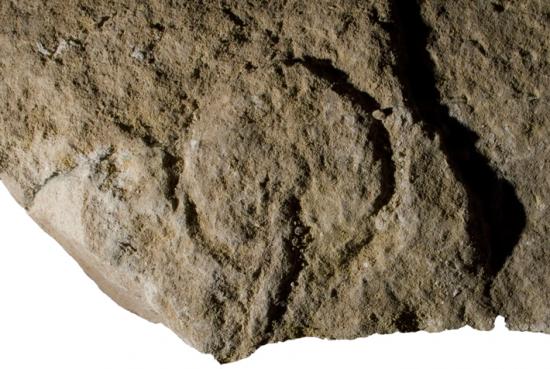
(Courtesy Raphaëlle Bourrillon)
Sergeac, France - Archaeologists have dated an engraving of a vulva found on a one-and-a-half-ton limestone block at Abri Castanet, a collapsed rock shelter in France, to about 37,000 years ago. That figure, however, is only a minimum age for the rock carving. The date, announced in May, actually corresponds to the approximate time when the rock shelter’s roof, of which the engraved block was once a part, collapsed. The engraving is thus one of the earliest examples of European wall art, likely older than the elaborate paintings 200 miles east in Chauvet Cave.
The block was found directly above a surface containing hundreds of artifacts from the early Aurignacian culture, the earliest modern humans in Europe. An imprint of the vulva on the shelter floor, along with a lack of sediment buildup between the block and the surface, suggested that radiocarbon dating of several pieces of bone smashed by the fallen block would give an accurate age of the roof collapse and an approximate age of the engraving.
“We see vulva again and again and again,” says New York University archaeologist Randall White about Aurignacian sites in the region near Abri Castanet (See “Letter from France"). “The fact that they’re repeating the same forms suggests that it is conventionalized in a way that allowed these people to relate to the meaning.” (Nikhil Swaminathan)
The First Pots
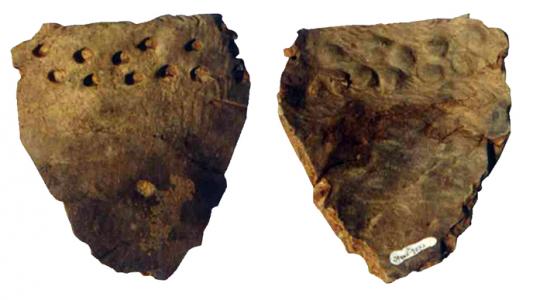
(Courtesy Science/AAAS)
Jiangxi Province, China. The invention of pottery for collecting, storing, and cooking food was a key development in human culture and behavior. Until recently, it had been thought that the emergence of pottery was part of the Neolithic Revolution around 10,000 years ago, which also brought agriculture, domesticated animals, and groundstone tools. Finds of much older pottery have put this theory to rest. This year, archaeologists dated what is now thought to be the oldest known pottery in the world, from the site of Xianrendong Cave in the Jiangxi Province of southeastern China. The cave had been dug before, in the 1960s, 1990s, and 2000, but the dating of its earliest ceramics was uncertain. Researchers from China, the United States, and Germany reexamined the site to find samples for radiocarbon dating. While the area had particularly complex stratigraphy—too complex and disturbed to be reliable, according to some—the researchers are confident that they have dated the earliest pottery from the site to 20,000 to 19,000 years ago, several thousand years before the next oldest examples. “These are the earliest pots in the world,” says Harvard’s Ofer Bar-Yosef, a coauthor on the Science paper reporting the finds. He also cautions, “All this does not mean that earlier pots will not be discovered in South China.” ((Courtesy Science/AAAS))
Scottish “Frankenstein” Mummies
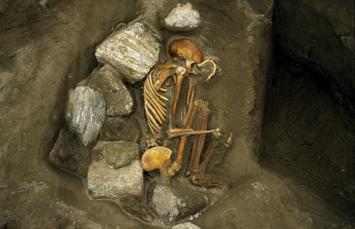
(Courtesy Mike Parker Pearson)
South Uist, Scotland - Instances of deliberate mummification in Europe are rare, but, while performing excavations in 2001 at Cladh Hallan, a Bronze Age settlement on the island of South Uist in Scotland’s Outer Hebrides, archaeologists found a pair of 3,000-year-old skeletons that fit the bill.
Both skeletons, one male and one female, were buried in the fetal position. Tests indicated they had been intentionally preserved for some time in nearby peat bogs, where microbes prevented them from fully decomposing, before they were eventually retrieved. “Mummification has been surprisingly widespread throughout world history, but this is the first time we’ve seen clear evidence that it was employed during the Bronze Age on the British Isles,” says University College London archaeologist Mike Parker Pearson.
Further examination of the remains led to another startling discovery. The male skeleton is actually a composite. Its torso, skull and neck, and lower jaw belong to three separate men. New DNA tests prove that the female skeleton is also a composite formed from a male skull, a female torso, and the arm of a third person, whose gender has yet to be determined. Carbon dating indicates that the skull of the female mummy is probably 50 to 200 years older than the torso.
Archaeologists have yet to agree why these remains were mummified and then mixed together. “The mixing of remains could have been designed to combine different ancestries or families into a single line of descent,” Parker Pearson explains. “At the time, land rights would have depended on ancestral claims, so perhaps having ancestors around ‘in the flesh’ was the prehistoric equivalent of a legal document.” (Erin Mullally)
2,000-Year-Old Stashed Treasure
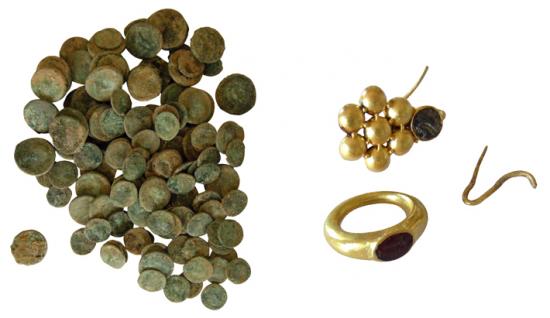
(Courtesy Israel Antiquities Authority)
Kiryat Gat, Israel - This past summer archaeologists discovered a veritable treasure chest of jewelry and coins buried inside a pit in the courtyard of an ancient building in southern Israel’s Kiryat Gat region. According to the Israel Antiquities Authority’s Sa’ar Ganor, the cache likely dates to the time of the Bar Kokhba revolt, which lasted from A.D. 132 to 135, and was one of the largest Jewish uprisings against the Romans. “This was probably an emergency cache that was concealed at a time of impending danger by a wealthy woman who wrapped her jewelry and money in a cloth and hid them deep in the ground,” says Ganor. “It’s now clear that the owner never returned to claim it.” While there are other contemporary hoards from Israel, this example is exceptional for the inclusion of several gold coins, rare in Israel at this time. (Mati Milstein)
Oldest Egyptian Funerary Boat
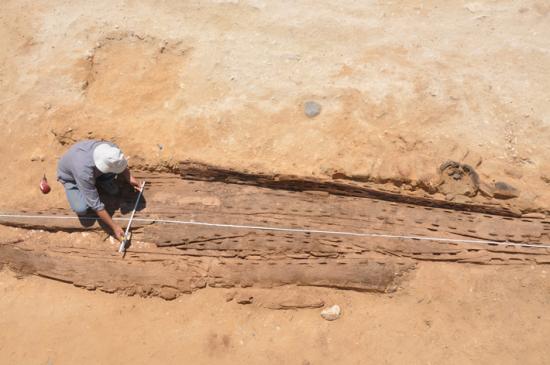
(Courtesy Egyptian Ministry of Antiquities)
Abu Rawash, Egypt - Egyptologist Yann Tristant was reading a 1914 excavation report on a First Dynasty (ca. 3150–2890 B.C.) tomb at the elite cemetery of Abu Rawash when he noticed something strange. The author, legendary French archaeologist Pierre Montet, wrote that just north of the mudbrick tomb, or mastaba, he had uncovered a wooden floor. That seemed bizarre to Tristant, of Macquarie University in Sydney, because he knew that no other archaeologists have reported finding wooden floors around mastabas. Sensing a mystery, he directed his team to excavate at the same spot Montet had almost a century before. The hunch paid off and led Tristant to a pit bounded by a brick wall that held the oldest boat found in Egypt, a 20-footlong vessel dating to 2950 B.C.
It’s clear the boat played some role in the burial ceremonies of the tomb’s owner, a high-ranking official. Tristant uncovered artifacts nearby that point to a lavish funerary feast, including ceramic beer jars and bread molds. Ceremonial boats have been found at tombs at royal cemeteries; they were intended to symbolically carry pharaohs into the afterlife. But since so few boats have been found at nonroyal tombs, Tristant hesitates to speculate exactly what religious function the Abu Rawash vessel served. “It’s a good example of why we must sometimes re-excavate sites,” says Tristant. “I never would have expected to find a boat at a tomb like this.” (Eric A. Powell)